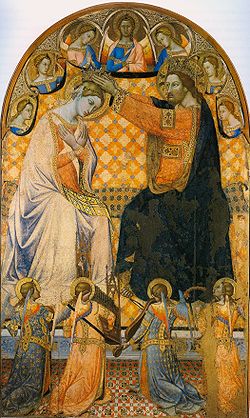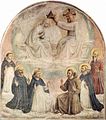Coronation of the Virgin
The Coronation of the Virgin Mary in Heaven | |
|---|---|
 | |
| Litany of Loreto by Pope Sixtus V (1587): Queen of Angels and All Saints, Queen assumed into Heaven Pope Pius XII (1954): Queen of Heaven Second Vatican Council (1964): Queen of the Universe (Lumen Gentium, Section #59) | |
| Venerated in | Roman Catholic Church |
| Feast | May 31st (until 1968) August 22nd (present) |
| Attributes | Mary crowned in Heaven by Jesus or jointly with God the Father, surrounded by Cherubim and/or Saints |

The Coronation of the Virgin or Coronation of Mary is a subject in Christian art, especially popular in Italy in the 13th to 15th centuries, but continuing in popularity until the 18th century and beyond. Christ, sometimes accompanied by God the Father and the Holy Spirit in the form of a dove, places a crown on the head of Mary as Queen of Heaven. In early versions the setting is a Heaven imagined as an earthly court, staffed by saints and angels; in later versions Heaven is more often seen as in the sky, with the figures seated on clouds. The subject is also notable as one where the whole Christian Trinity is often shown together, sometimes in unusual ways. Crowned Virgins are also seen in Eastern Orthodox Christian icons, specifically in the Russian Orthodox church after the 18th century. Mary is sometimes shown, in both Eastern and Western Christian art, being crowned by one or two angels, but this is considered a different subject.
The subject became common as part of a general increase in devotion to Mary in the Early Gothic period, and is one of the commonest subjects in surviving 14th-century Italian panel paintings, mostly made to go on a side-altar in a church. The great majority of Roman Catholic churches had (and have) a side altar or "Lady chapel" dedicated to Mary. The subject is still often enacted in rituals or popular pageants called May crownings, although the crowning is performed by human figures.
Official status and feast
[edit]The belief in Mary as Queen of Heaven obtained the papal sanction of Pope Pius XII in his encyclical Ad Caeli Reginam (English: 'Queenship of Mary in Heaven') of October 11, 1954.[1]
The Roman Catholic Church celebrates the feast every August 22, in place of the former octave day of the Assumption of Mary in 1969, a change made by Pope Paul VI. The feast was formerly celebrated on May 31, at the end of the Marian month, where the present liturgical calendar now commemorates the Feast of the Visitation. In addition, there are Canonical coronations authorized by the Pope which are given to specific Marian images venerated in a particular place.
The act of the Virgin Mother of God being physically crowned as Queen of Heaven and Earth after her Assumption is a traditional Catholic belief echoed in the Rosary. The Coronation of the Blessed Virgin Mary is the fifth of the Glorious Mysteries of the Rosary.[2]
The Coronation of the Blessed Virgin is also a subject of devotion throughout Christianity. Beyond art, the Coronation is a central motif in Marian processions around the world, such as the Grand Marian Procession in Los Angeles, revived by the Queen of Angels Foundation.
Origin
[edit]The scene is the final episode in the Life of the Virgin, and follows her Assumption – not yet dogma in the Middle Ages – or Dormition. The scriptural basis is found in the Song of Songs (4.8), Psalms (45.11–12) and Revelation (12.1–7). A sermon wrongly believed to be by Saint Jerome elaborated on these and was used by standard medieval works such as the Golden Legend and other writers. The subject also appears in Books of Hours. The title "Queen of Heaven", or Regina Coeli, for Mary goes back to at least the 12th century.
The subject also drew from the idea of the Virgin as the “Throne of Solomon”, that is the throne on which a Christ Child sits in a Madonna and Child. It was felt that the throne itself must be royal. This is related to the popular sedes sapientiae motif. In general, the art of this period, often paid for by royalty and the nobility, increasingly regarded the heavenly court as a mirror of earthly ones.
The subject seems to first appear in art, unusually, in England, where f. 102v in the Benedictional of St Æthelwold (963-984), for the Feast of the Assumption, shows the death and Coronation of the Virgin, possibly the first Western depiction.[3] There are also a tympanum over the door of the church at Quenington in Gloucestershire of perhaps 1140, and another damaged example from Reading Abbey (Reading, Berkshire).[3] From around this time it was rapidly adopted and is prominent in the portals of French Gothic cathedrals[4] such as Senlis, Chartres, Strasbourg, Laon, Notre-Dame de Paris, Amiens and Reims, indeed most 13th-century cathedrals in France.
There are three examples extant on Devon rood screen dados: at East Portlemouth, Holne, and Torbryan.
The act of coronation is deeply rooted in Bible, reflecting the promise of eternal reward for all believers, as seen in James 1:12. The Scripture mentions five crowns that believers may receive in Heaven, one of which is the crown of life, awarded to "those who persevere under trials" (Revelation 2:10). Once Mary is recognized as a figure of the Church and the "exemplary realization" of the Church,[5] she anticipates this promise and is the first to be crowned. Her coronation symbolizes hope for all believers, echoing the universal promise of salvation within the Christian faith.
Composition
[edit]In earlier versions, Mary and Christ often sit side-by-side on a wide throne, and typically are only accompanied by angels in smaller altarpieces, although these were often in polyptych form, and had saints on side-panels, now often separated. Later, God the Father often sits to the left of Christ, with the Holy Spirit hovering between them, and Mary kneeling in front and below them. Christ and the Father are normally differentiated by age, and to some extent by costume: God the Father is often wearing a beehive-shaped crown, reminiscent of a Papal tiara.
By the 15th century, more individual interpretations are found. From the High Renaissance onwards, the subject is often combined with an Assumption as a group of Apostles is on the earthly space below the heavenly scene, sometimes with Mary's empty tomb. As the central panel of altarpieces became larger until it abandoned the predella and side-panels, the Coronation was one subject suited to a very tall composition, especially if it had Apostles or other saints of importance to the community depicted on the lower sections.
Crown of Mary
[edit]The "crown" of Mary has been mentioned since the 6th century, as "corona virginum" (crown of virgins).[6] The crown has several meanings in secular depictions. The ancient laurel crown in the Olympic Games signified victory, and a crown in gold and precious stones indicate power and wealth. In Christian iconography, the crown develops religious meanings. In an early mosaic in Ravenna, Italy, virgins present a crown to the child and Mary as a gesture of humility.[7] The Three kings present their crowns to the newly born Jesus as a symbol of secular power submitting to Christ.[7] Marian crowns often include elements of victory and glory, especially during the Baroque period.
A crowned Mary is usually seen in Jesse Trees, which stress her earthly royal descent from the House of David, something accorded considerable importance in the Middle Ages. In Santa Maria in Trastevere in Rome, she is shown as the mother of Christ, who participates in his kingdom.[8] The Latin text there, adapted from the Song of Songs, reads: Tota pulchra es, amica mea, veni coronavi.
Individual works with articles
[edit]- Coronation of the Virgin (Beccafumi)
- Coronation of the Virgin (El Greco, Illescas)
- Coronation of the Virgin (Filippo Lippi), Uffizi
- Marsuppini Coronation by Filippo Lippi, Vatican Museums
- Coronation of the Virgin (Fra Angelico, Louvre)
- Coronation of the Virgin (Fra Angelico, Uffizi)
- Coronation of the Virgin (Gentile da Fabriano)
- Coronation of the Virgin (Lorenzo Monaco)
- Coronation of the Virgin with saints by Piero del Pollaiuolo in the church of Sant'Agostino, San Gimignano
- Coronation of the Virgin (Rubens), Hermitage Museum
- Coronation of the Virgin (Velázquez)
- Coronation of the Virgin Altarpiece by Moretto da Brescia
- Oddi Altarpiece, Raphael
- The Coronation of the Virgin by Enguerrand Quarton
Gallery
[edit]To 1500
[edit]-
Giuliano da Rimini, 14th century
-
Paolo Veneziano, 1324
-
Agnolo Gaddi, c. 1380
-
Martino di Bartolomeo, 1400
-
German altar, 1413-1422
-
Gentile da Fabriano, 1422-1425
-
Bicci di Lorenzo, 1430
-
Fra Angelico, Louvre with a larger court setting, 1430-1431
-
Fra Angelico, Uffizi, 1434-1435
-
Fra Angelico, 1437-1446
-
Filippo Lippi, 1441-1447
-
Giovanni di Paolo, 1455
-
German 15th-century version with donors, Master of the Life of the Virgin
-
Filippo Lippi (1467-1469); apse of the cathedral of Spoleto
-
Piero del Pollaiuolo, 1483
-
Botticelli, with only God the Father in evidence, 1490-1492
-
Michael Sittow, 1492-1496
-
Swedish 15th-century altarpiece in carved and painted wood (Källunge Church)
Unusual Trinities
[edit]-
Conventional depiction of the Trinity, with Christ showing the wounds of his Passion
-
Enguerrand Quarton with Christ and God the Father as identical figures, as specified by the cleric who commissioned the work
-
Page from Book of Hours, with three human figures for the Trinity
-
Jean Fouquet, also with three human figures, in this case three identical depictions of Jesus
Post-1500
[edit]-
Albrecht Dürer combines the subject with an Assumption
-
Raphael, 1502-1504
-
Pietro Perugino, 1504
-
Ridolfo Ghirlandaio, 1504
-
El Greco 1591
-
El Greco, 1597
-
Giulio Cesare Procaccini, c. 1604-1607
-
Attributed to Amaro do Vale, c. 1615-1619
-
Banner of the Irish Catholic Confederation (1642–1652)
Post-1800
[edit]-
Domingos Sequeira, c. 1830
-
Stained glass window at St. Michael's Cathedral (Toronto) depicts Coronation of the Virgin.
-
19th-century German altar
See also
[edit]Notes
[edit]- ^ Pope Pius XII, Ad Caeli Reginam, 11 October 1954, Dicastero per la Comunicazione
- ^ "Glorious Mysteries", Vatican
- ^ a b Wright, 83
- ^ " The Coronation of the Virgin, 1324", National Gallery of Art
- ^ Catechism of the Catholic Church (2nd ed.). Libreria Editrice Vaticana. 2019. Paragraph 967.
- ^ F Tschochner, Krone in Marienlexikon Eos St. Ottilien 1988, p.685
- ^ a b Tschochner 685
- ^ "Santa Maria in Trastevere – Rome, Italy". Living Mosaics. Mozaico.
References
[edit]- Wright, Rosemary Muir, Sacred Distance: Representing the Virgin Mary in Italian Altarpieces, 1300-1630, 2006, Manchester University Press, ISBN 9780719055454






























![Attributed to Amaro do Vale [pt], c. 1615-1619](http://upload.wikimedia.org/wikipedia/commons/thumb/8/8f/Coroa%C3%A7%C3%A3o_da_Virgem_%281615-19%29_-_Amaro_do_Vale_%28attrib.%29.png/120px-Coroa%C3%A7%C3%A3o_da_Virgem_%281615-19%29_-_Amaro_do_Vale_%28attrib.%29.png)




